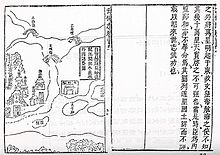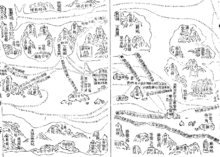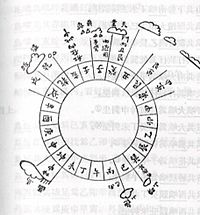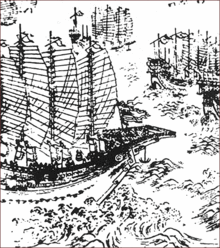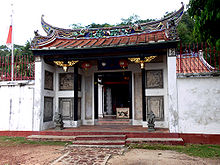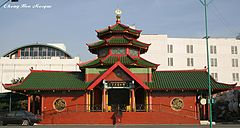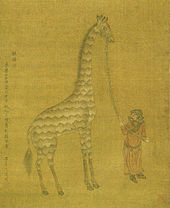- Zheng He
-
Zheng He 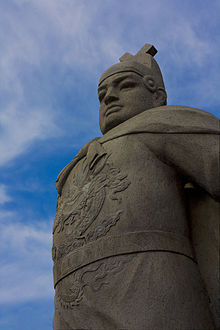
Statue from a modern monument to Zheng He at the Stadthuys Museum in Malacca Town, Malaysia.Born 1371
Yunnan, ChinaDied 1433 Other names Chinese: 馬三寶 Occupation Asian explorer Title Admiral of the Ocean Sea Religion Islam Zheng He Chinese name Traditional Chinese 鄭和 Simplified Chinese 郑和 Transcriptions Mandarin - Hanyu Pinyin Zhèng Hé - Tongyong Pinyin Jhèng Hé - Wade–Giles Cheng Ho - IPA [tʂɤ̂ŋ xɤ̌] - Yale Romanization Jèng Hé - Gwoyeu Romatzyh Jenq Her Min - Hokkien POJ Tēⁿ-hô Cantonese (Yue) - Jyutping Zeng6 Wo4 - IPA [tsɛ̀ːŋ wɔ̭ː] - Yale Romanization Jehng Wòh Alternative Chinese name Traditional Chinese 馬三寶 Simplified Chinese 马三宝 Transcriptions Mandarin - Hanyu Pinyin Mǎ Sānbǎo - Tongyong Pinyin Mǎ Sānbǎo - Wade–Giles Ma San-pao - Yale Romanization Mǎ Sānbǎu - Gwoyeu Romatzyh Maa Sanbao Min - Hokkien POJ Bé-sam-pó Cantonese (Yue) - Jyutping Maa5 Saam1 bou2 - IPA [ma̬ː sáːmboǔ] - Yale Romanization Maáh Sáam boú Persian name Persian حاجی محمود شمس الدين Zheng He (1371–1433; simplified Chinese: 郑和; traditional Chinese: 鄭和; pinyin: Zhèng Hé), also known as Ma Sanbao (simplified Chinese: 马三宝; traditional Chinese: 馬三寶) and Hajji Mahmud Shamsuddin (Persian: حاجی محمود شمس الدين) was a Hui-Chinese mariner, explorer, diplomat and fleet admiral, who commanded voyages to Southeast Asia, South Asia, the Middle East, and East Africa, collectively referred to as the Voyages of Zheng He or Voyages of Cheng Ho from 1405 to 1433.
Contents
Life
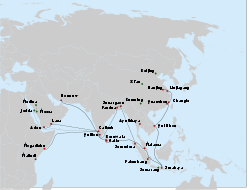 The route of the 7th voyage of Zheng He's fleet. Solid line: main fleet; dashed line: a possible route of Hong Bao's squadron; dotted line: a trip of seven Chinese sailors, including Ma Huan, from Calicut to Mecca on a native ship. Cities visited by Zheng He's fleet or its squadron on the 7th or any of the previous voyages are shown in red.
The route of the 7th voyage of Zheng He's fleet. Solid line: main fleet; dashed line: a possible route of Hong Bao's squadron; dotted line: a trip of seven Chinese sailors, including Ma Huan, from Calicut to Mecca on a native ship. Cities visited by Zheng He's fleet or its squadron on the 7th or any of the previous voyages are shown in red.
Zheng, born as Ma He[1] (馬和 / 马和), was the second son of a Muslim family which also had four daughters, from Kunyang, present day Jinning, just south of Kunming near the southwest corner of Lake Dian in Yunnan.[2][3][4]
He was the great great great grandson of Sayyid Ajjal Shams al-Din Omar, a Persian who served in the administration of the Mongolian Empire and was appointed governor of Yunnan during the early Yuan Dynasty.[5][6] Both his grandfather and great-grandfather carried the title of Hajji, which indicates they had made the pilgrimage to Mecca. His great-grandfather was named Bayan and may have been a member of a Mongol garrison in Yunnan.[2]
In 1381, the year his father was killed, following the defeat of the Northern Yuan, a Ming army was dispatched to Yunnan to put down the army of the Mongol Yuan loyalist Basalawarmi during the Ming conquest of Yunnan. Ma He, then only eleven years old, was captured by the Ming Muslim troops of Lan Yu and Fu Youde and made a eunuch. He was sent to the court of one the emperor's son, Zhu Di the Prince of Yan, where he was called San Bao (三寶/三宝, or 三保[7]) meaning 'Three Jewels.' The young eunuch eventually became a trusted adviser of the Prince of Yan, and assisted the prince in his insurrection against his nephew the Jianwen Emperor. For his valor in this war, the eunuch received the name Zheng He from his master. Once Zhu Di deposed Jianwen and became crowned as Yongle Emperor (r. 1403-1424), Zheng He continued serving in his court as a Eunuch Grand Director (太監, taijian).[2][4][8] It was during the Yongle era that Zheng He, with the rank of Chief Envoy (正使, zheng shi) carried his first of six overseas missions.
In 1425 Yongle's successor the Hongxi Emperor appointed Zheng He to be Defender of Nanjing. In 1428 the Xuande Emperor ordered him to complete the construction of the magnificent Buddhist nine-storied Da Baoen Temple in Nanjing, and in 1430 appointed him to lead the seventh and final expedition to the "Western Ocean".[9] It is commonly believed that Zheng He died during the treasure fleet's last voyage, on the returning trip after the fleet reached Hormuz in 1433.
Expeditions
Between 1405 and 1433, the Ming government sponsored seven naval expeditions. The Yongle emperor designed them to establish a Chinese presence, impose imperial control over trade, impress foreign peoples in the Indian Ocean basin and extend the empire's tributary system. It has also been claimed, on the basis of later texts, that the voyages also presented an opportunity to seek out Zhu Yunwen (the previous emperor whom the Yongle emperor had usurped and who was rumored to have fled into exile) – possibly the "largest scale manhunt on water in the history of China".[10]
Zheng He was placed as the admiral in control of the huge fleet and armed forces that undertook these expeditions. Wang Jinghong was appointed his second in command. Zheng He's first voyage, which departed July 11, 1405, from Suzhou,[11]:203 consisted of a fleet of 317 ships[12][13][14] (other sources say 200 ships) holding almost 28,000 crewmen (each ship housing up to 500 men).[12]
Zheng He's fleets visited Arabia, Brunei, East Africa, India, Maritime Southeast Asia and Thailand, dispensing and receiving goods along the way.[14] Zheng He presented gifts of gold, silver, porcelain and silk; in return, China received such novelties as ostriches, zebras, camels, ivory and a giraffe.[11]:206[14][15]
While Zheng He's fleet was unprecedented (compared to previous voyages from China to the east Indian Ocean), the routes were not. Zheng He's fleet was following long-established, well-mapped routes. Sea-based trade links had existed between China and the Arabian peninsula since the Han Dynasty (there being trade with the Roman Empire at that time.) During the Three Kingdoms, the king of Wu sent a diplomatic mission along the coast of Asia, reaching as far as the Eastern Roman Empire. During the Song Dynasty, there was large scale maritime trade from China reaching as far as the Arabian peninsula and East Africa.[16]
Zheng He generally sought to attain his goals through diplomacy, and his large army awed most would-be enemies into submission. But a contemporary reported that Zheng He "walked like a tiger" and did not shrink from violence when he considered it necessary to impress foreign peoples with China's military might.[17] He ruthlessly suppressed pirates who had long plagued Chinese and southeast Asian waters. For example, he would defeat Chen Zuyi, one of the most feared and respected pirate captains, and return him back to China for execution.[18] He also waged a land war against the Kingdom of Kotte in Ceylon, and he made displays of military force when local officials threatened his fleet in Arabia and East Africa. From his fourth voyage, he brought envoys from thirty states who traveled to China and paid their respects at the Ming court.
In 1424, the Yongle Emperor died. His successor, the Hongxi Emperor (reigned 1424–1425), decided to stop the voyages during his short reign. Zheng He made one more voyage during the reign of Hongxi's son Xuande Emperor (reigned 1426–1435), but after that the voyages of the Chinese treasure ship fleets were ended. Xuande believed his father's decision to halt the voyages meritorious, and thus "there would be no need to make a detailed description of his grandfather’s sending Zheng He to the Western Oceans."[19] This, and the fact that the voyages "were contrary to the rules stipulated in the Huangming zuxun, Ancestral Injunctions of the August Ming,"[19] the royal founding documents laid down by the Hongwu Emperor, account for the Ming "neglect" of Zheng He in official accounts and the scant records of the voyages available for later historians.[19]
Zheng He died during the treasure fleet's last voyage. Although he has a tomb in China, it is empty: he was, like many great admirals, buried at sea.[20]
Voyages
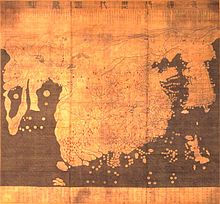 The Kangnido map (1402) predates Zheng's voyages and suggests that he had quite detailed geographical information on much of the Old World.
The Kangnido map (1402) predates Zheng's voyages and suggests that he had quite detailed geographical information on much of the Old World.
Order Time Regions along the way[21][22] 1st Voyage 1405–1407 Champa, Java, Palembang, Malacca, Aru (id:Aru), Samudera, Lambri, Ceylon, Kollam, Cochin, Calicut 2nd Voyage 1407–1409 Champa, Java, Siam, Cochin, Ceylon 3rd Voyage 1409–1411 Champa, Java, Malacca, Sumatra, Ceylon, Quilon, Cochin, Calicut, Siam, Lambri, Kayal, Coimbatore, Puttanpur 4th Voyage 1413–1415 Champa, Java, Palembang, Malacca, Sumatra, Ceylon, Cochin, Calicut, Kayal, Pahang, Kelantan, Aru, Lambri, Hormuz, Maldives, Mogadishu, Barawa, Malindi, Aden, Muscat, Dhofar 5th Voyage 1416–1419 Champa, Pahang, Java, Malacca, Samudera, Lambri, Ceylon, Sharwayn, Cochin, Calicut, Hormuz, Maldives, Mogadishu, Barawa, Malindi, Aden 6th Voyage 1421–1422 Hormuz, East Africa, countries of the Arabian Peninsula 7th Voyage 1430–1433 Champa, Java, Palembang, Malacca, Sumatra, Ceylon, Calicut, Fengtu [23][24]... (18 states in total) Zheng He led seven expeditions to what the Chinese called "the Western Ocean" (Indian Ocean). He brought back to China many trophies and envoys from more than thirty kingdoms – including King Vira Alakeshwara of Ceylon, who came to China as a captive to apologize to the Emperor.
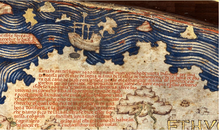 Detail of the Fra Mauro map relating the travels of a junk into the Atlantic Ocean in 1420. The ship also is illustrated above the text.
Detail of the Fra Mauro map relating the travels of a junk into the Atlantic Ocean in 1420. The ship also is illustrated above the text.
There are speculations that some of Zheng's ships may have traveled beyond the Cape of Good Hope. In particular, the Venetian monk and cartographer Fra Mauro describes in his 1459 Fra Mauro map the travels of a huge "junk from India" 2,000 miles into the Atlantic Ocean in 1420. What Fra Mauro meant by 'India' is not known and some scholars believe he meant an Arab ship.[25] However, Professor Su Ming-Yang thinks "the ship is European, as it is fitted with a crow’s nest, or lookout post, at the masthead, and has sails fitted to the yards, unlike the batten sails of Chinese ships."[26]
Zheng himself wrote of his travels:
We have traversed more than 100,000 li (50,000 kilometers or 30,000 miles) of immense water spaces and have beheld in the ocean huge waves like mountains rising in the sky, and we have set eyes on barbarian regions far away hidden in a blue transparency of light vapors, while our sails, loftily unfurled like clouds day and night, continued their course [as rapidly] as a star, traversing those savage waves as if we were treading a public thoroughfare… — Tablet erected by Zheng He, Changle, Fujian, 1432. Louise Levathes
Sailing charts
Zheng He's sailing charts were published in a book entitled Wubei Zhi (Treatise on Armament Technology) written in 1621 and published in 1628 but traced back to Zheng He's and earlier voyages.[27] It was originally a strip map 20.5 cm by 560 cm that could be rolled up, but was divided into 40 pages which vary in scale from 7 miles/inch in the Nanjing area to 215 miles/inch in parts of the African coast.[28]
There is little attempt to provide an accurate 2-D representation; instead the sailing instructions are given using a 24 point compass system with a Chinese symbol for each point, together with a sailing time/distance, which takes account of the local currents and winds. Sometimes depth soundings are also provided. It also shows bays, estuaries, capes and islands, ports and mountains along the coast, important landmarks (pagodas, temples) and shoal rocks. Of 300 named places outside China, more than 80% can be confidently located. There are also fifty observations of stellar altitude.
Size of the ships
Traditional and popular accounts of Zheng He's voyages have described a great fleet of gigantic ships, far larger than any other wooden ships in history. Some modern scholars consider these descriptions to be exaggerated.
Chinese records[29] assert that Zheng He's fleet sailed as far as East Africa. According to medieval Chinese sources, Zheng He commanded seven expeditions. The 1405 expedition consisted of 27,800 men and a fleet of 62 treasure ships supported by approximately 190 smaller ships.[30][31] The fleet included:
- Treasure ships (Chinese:宝船), used by the commander of the fleet and his deputies (nine-masted, about 126.73 metres (416 ft) long and 51.84 metres (170 ft) wide), according to later writers[citation needed]. This is more or less the size and shape of a football field.[32][33]
- Equine ships (Chinese:馬船), carrying horses and tribute goods and repair material for the fleet (eight-masted, about 103 m (339 ft) long and 42 m (138 ft) wide).[32]
- Supply ships (Chinese:粮船), containing staple for the crew (seven-masted, about 78 m (257 ft) long and 35 m (115 ft) wide).[32]
- Troop transports (Chinese:兵船), six-masted, about 67 m (220 ft) long and 25 m (83 ft) wide.[32]
- Fuchuan warships (Chinese:福船), five-masted, about 50 m (165 ft) long.[32]
- Patrol boats (Chinese:坐船), eight-oared, about 37 m (120 ft) long.[32]
- Water tankers (Chinese:水船), with 1 month's supply of fresh water.[32]
Six more expeditions took place, from 1407 to 1433, with fleets of comparable size.[34]
If the accounts can be taken as factual, Zheng He's treasure ships were mammoth ships with nine masts, four decks, and were capable of accommodating more than 500 passengers, as well as a massive amount of cargo. Marco Polo and Ibn Battuta both described multi-masted ships carrying 500 to 1000 passengers in their translated accounts.[35] Niccolò Da Conti, a contemporary of Zheng He, was also an eyewitness of ships in Southeast Asia, claiming to have seen 5 masted junks weighing about 2000 tons.[36] There are even some sources that claim some of the treasure ships might have been as long as 600 feet.[37][38] On the ships were navigators, explorers, sailors, doctors, workers, and soldiers along with the translator and diarist Gong Zhen.
The largest ships in the fleet, the treasure ships described in Chinese chronicles, would have been several times larger than any wooden ship ever recorded in history, surpassing l'Orient (65 m/213.3 ft long) which was built in the late 18th century. The first ships to attain 126 m (413.4 ft) long were 19th century steamers with iron hulls. Some scholars argue that it is highly unlikely that Zheng He's ship was 450 feet (137.2 m) in length, some estimating that they were 390–408 feet (118.9–124.4 m) long and 160–166 feet (48.8–50.6 m) wide instead[39] while others put them as small as 200–250 feet (61.0–76.2 m) in length, which would make them smaller than the equine, supply, and troop ships in the fleet.[40]
One explanation for the seemingly inefficient size of these colossal ships was that the largest 44 Zhang treasure ships were merely used by the Emperor and imperial bureaucrats to travel along the Yangtze for court business, including reviewing Zheng He's expedition fleet. The Yangtze river, with its calmer waters, may have been navigable by these treasure ships. Zheng He, a court eunuch, would not have had the privilege in rank to command the largest of these ships, seaworthy or not. The main ships of Zheng He's fleet were instead 6 masted 2000-liao ships.[41][42]
Accounts of medieval travellers
The characteristics of the Chinese ships of the period are described by Western travelers to the East, such as Ibn Battuta and Marco Polo. According to Ibn Battuta, who visited China in 1347:
We stopped in the port of Calicut, in which there were at the time thirteen Chinese vessels, and disembarked. China Sea traveling is done in Chinese ships only, so we shall describe their arrangements. The Chinese vessels are of three kinds; large ships called chunks (junks), middle sized ones called zaws (dhows) and the small ones kakams. The large ships have anything from twelve down to three sails, which are made of bamboo rods plaited into mats. They are never lowered, but turned according to the direction of the wind; at anchor they are left floating in the wind.
Three smaller ones, the "half", the "third" and the "quarter", accompany each large vessel. These vessels are built in the towns of Zaytun and Sin-Kalan. The vessel has four decks and contains rooms, cabins, and saloons for merchants; a cabin has chambers and a lavatory, and can be locked by its occupants.
This is the manner after which they are made; two (parallel) walls of very thick wooden (planking) are raised and across the space between them are placed very thick planks (the bulkheads) secured longitudinally and transversely by means of large nails, each three ells in length. When these walls have thus been built the lower deck is fitted in and the ship is launched before the upper works are finished.-
- - Ibn Battuta[citation needed]
South and Southeast Asia
In his book 'The Overall Survey of the Ocean Shores' (Chinese: 瀛涯勝覽) written in 1416, Ma Huan, one of Zheng He's chroniclers and interpreters, gave very detailed accounts of his observations of the peoples' customs and lives in ports they visited.[43]
The Galle Trilingual Inscription stone tablet, erected by Zheng He around 1410 in Sri Lanka, records details about contributions of gold, silver, and silk that Zheng He made on behalf of the emperor at a Buddhist mountain temple.[44][45] Also, a commemorative pillar at the temple of the Taoist goddess Tian Fei, the Celestial Spouse, in Fujian province records details about his voyages.[46] It has the inscription:
- We have traversed more than 100,000 li (50,000 kilometers) of immense water spaces and have beheld in the ocean huge waves like mountains rising in the sky, and we have set eyes on barbarian regions far away hidden in a blue transparency of light vapors, while our sails, loftily unfurled like clouds day and night, continued their course [as rapidly] as a star, traversing those savage waves as if we were treading a public thoroughfare…
- —Erected by Zheng He, Changle, Fujian, 1432. Louise Levathes
In Malacca
At the time when his fleet first arrived in Malacca, Chinese people were already living there. Ma Huan refers to them as tángrén (Chinese: 唐人). Ming China found Malacca to be a useful transit centre for replenishment of fleet supplies, and received valuable gifts from Zheng He's fleet. The sultan and sultana of Malacca at the time visited China at the head of over 540 of their subjects and ample tribute. Sultan Mansur Shah (ruled 1459–1477) later dispatched Tun Perpatih Putih as his envoy to China, carrying a letter from the sultan to the Ming emperor. The letter requested the hand of an imperial daughter in marriage. In the year 1459, a princess (Hang Li Po or Hang Liu), was sent by the Ming emperor to marry the sultan. The princess came with 500 sons of ministers and a few hundred handmaidens as her entourage. They eventually settled in Bukit Cina, Malacca. It is believed that a significant number of them married into the local populace.[47] The descendants of these mixed marriages are locally known today as Peranakan and still use the honorifics Baba (male title) and Nyonya (female title).
In Malaysia today, many people believe that Admiral Zheng He (who died in 1433) sent princess Hang Li Po to Malacca in the year 1459. However there is no record of Hang Li Po (or Hang Liu) in Ming history. She is mentioned only within Malaccan folklore and in the Sejarah Melayu or Malay Annals.
Islam
Islam in China  HistoryHistory
HistoryHistory
Tang Dynasty • Song Dynasty
Panthay rebellion • 1911-Present
Yuan Dynasty • Ming Dynasty
Qing Dynasty • Dungan revolts (1862-1877, 1895-1896)Major figuresChang Yuchun • Hu Dahai • Mu Ying • Lan Yu • Yeheidie'erding
Hui Liangyu • Ma Bufang
Ma Hualong
Zheng He • Liu Zhi
Haji Noor • Yusuf Ma DexinAccounts contemporary to Zheng He's era suggest he may have been a Muslim; these include the writings of the Muslim Ma Huan.
Indonesian religious leader and Islamic scholar Hamka (1908–1981) wrote in 1961: "The development of Islam in Indonesia and Malaya is intimately related to a Chinese Muslim, Admiral Zheng He."[48] In Malacca he built granaries, warehouses and a stockade. Indonesian scholar Slamet Muljana writes: "Zheng He built Chinese Muslim communities first in Palembang, then in San Fa (West Kalimantan), subsequently he founded similar communities along the shores of Java, the Malay Peninsula and the Philippines. They preached Islam according to the Hanafi school of thought and in Chinese language."[citation needed]
Li Tong Cai, in his book 'Indonesia – Legends and Facts', writes: "in 1430, Zheng He had already successfully established the foundations of the Hui religion Islam. After his death in 1434, Hajji Yan Ying Yu became the force behind the Chinese Muslim community, and he delegated a few local Chinese as leaders, such as trader Sun Long from Semarang, Peng Rui He and Hajji Peng De Qin. Sun Long and Peng Rui He actively urged the Chinese community to 'Javanise'. They encouraged the younger Chinese generation to assimilate with the Javanese society, to take on Javanese names and their way of life. Sun Long's adopted son Chen Wen, also known as Radin Pada (Raden Patah), is the son of King Majapahit and his Chinese wife."[49]
The Hanafi Islam that some from the fleet may have propagated lost almost all contact with its parent in China, and gradually was totally absorbed by the local Shafi’i school of thought. Long before 600 years had elapsed, the presence of ethnic Chinese Muslims had declined to almost nil.[50]
Connection to the history of Late Imperial China
In the 1950s, historians such as John Fairbank and Joseph Needham popularized the idea that after Zheng He's voyages China turned away from the seas due to the Hai jin edict and was isolated from European technological advancements. Modern historians point out that Chinese maritime commerce did not totally stop after Zheng He, that Chinese ships continued to dominate Southeast Asian commerce until the 19th century and that active Chinese trading with India and East Africa continued long after the time of Zheng. The travels of the Chinese Junk Keying to the United States and England between 1846 and 1848 testify to the power of Chinese shipping until the 19th century. Moreover revisionist historians such as Jack Goldstone argue that the Zheng He voyages ended for practical reasons that did not reflect the technological level of China.[52]
Although the Ming Dynasty did ban shipping with the Hai jin edict, they eventually lifted this ban. By banning oceangoing shipping, the Ming (and later Qing) dynasties had forced countless numbers of people into black market smuggling. This reduced government tax revenue and increased piracy. The lack of an oceangoing navy then left China highly vulnerable to the Wokou pirates that ravaged China in the 16th century.[citation needed]
Richard von Glahn (University of California, Los Angeles Professor of History and a specialist in Chinese history) commented that a majority of school history texts present Zheng He wrongly; they "offer counterfactual arguments", and "emphasize China's missed opportunity." The "narrative emphasizes the failure" instead of Zheng He's accomplishments. He goes on to claim that "Zheng He reshaped Asia." According to him, maritime history in the fifteenth century is essentially the Zheng He story and the effects of Zheng He's voyages.
Von Glahn claims that Zheng He's influence lasted beyond his age, may be seen as the tip of an iceberg, and there is much more to the story of maritime trade and other relationships in Asia in the fifteenth century and beyond.[53]
State-sponsored Ming naval efforts declined dramatically after Zheng's voyages. Starting in the early 15th century, China experienced increasing pressure from resurgent Mongolian tribes from the north. In recognition of this threat and possibly to move closer to his family's historical geographic power base, in 1421 the emperor Yongle moved the capital north from Nanjing to present-day Beijing. From the new capital he could apply greater imperial supervision to the effort to defend the northern borders. At considerable expense, China launched annual military expeditions from Beijing to weaken the Mongolians. The expenditures necessary for these land campaigns directly competed with the funds necessary to continue naval expeditions.
In 1449 Mongolian cavalry ambushed a land expedition personally led by the emperor Zhengtong less than a day's march from the walls of the capital. In the Battle of Tumu Fortress the Mongolians wiped out the Chinese army and captured the emperor. This battle had two salient effects. First, it demonstrated the clear threat posed by the northern nomads. Second, the Mongols caused a political crisis in China when they released Zhengtong after his half-brother had proclaimed himself the new Jingtai emperor. Not until 1457 did political stability return when Zhengtong recovered the throne. Upon his return to power China abandoned the strategy of annual land expeditions and instead embarked upon a massive and expensive expansion of the Great Wall of China. In this environment, funding for naval expeditions simply did not happen.
Cultural Influence
In the decades after the last voyage, Imperial officials sought to eliminate memories of the voyages.[54] However, the adventures of the fleet captured the imagination of the Chinese, and novelizations of the voyages flourished.[55] An author from far inland Shaanxi would in 1597 write the grandest of the epics, Romance of the Three-Jeweled Eunuch, the distance from the coast and time gap since the last voyage attest to continued cultural power.[56]
In modern times, he is the continued subject of interest and a cultural reference. In Vernor Vinge's science fiction novel A Deepness in the Sky published in 1999, Qeng Ho, named after Zheng He, is the commercial traders in the human galactical system. The expeditions of Zheng He were featured in the 2005 novel "The Map Thief" by Heather Terrell. In 2009, China's CCTV released Zheng He Xia Xiyang, a television series specially produced in 2005 to mark the 600th anniversary of Zheng He's voyages. Gallen Lo starred as Zheng He.
Relics
- Nanjing Tianfeigong (南京天妃宫)
Zheng He built Tianfeigong (天妃宫, Tianfei palace) in Nanjing after the fleet returned from its first western voyage in 1407.
- Stele of Tongfan Deed (通番事跡碑)
The stele of Tongfan Deed (通番事跡, deed of foreign connection and exchange) is located in the Tianfeigong in Taicang, where they started their journey. It was submerged and disappeared, but has been rebuilt.
- Stele of Record of Tianfei Showing Her Presence and Power (天妃靈應之記碑)
In order to thank Tianfei for her blessings, Zheng He and his colleagues rebuilt Tianfeigong in Nanshan, Changle County, Fujian province before their seventh western voyage. They also raised a stele with the inscription Tian Fei Ling Ying Zhi Ji (天妃靈應之記, Record of Tianfei Showing Her Presence and Power), which tells about their voyages.
- Zheng He Stele in Sri Lanka
The Galle Trilingual Inscription in Sri Lanka was discovered in the city of Galle in 1911 and is preserved in the National Museum of Colombo. Three languages were used for the inscription: Chinese, Tamil and Persian. The inscription gives praise to Buddha and describes the fleet's donations to a Buddhist temple, the famous Tenavarai Nayanar temple of Tondeswaram.
Commemoration
Tomb and museum
Zheng He's tomb in Nanjing has been repaired and a small museum has been built next to it, although his body is missing as he was buried at sea off the Malabar Coast near Calicut in Western India.[57] However, his sword and other personal possessions were interred in the typical Muslim tomb inscribed with Arabic characters.
Zheng He's assistant Hong Bao's tomb was unearthed recently in Nanjing.
Maritime Day
In the People's Republic of China, 11 July is Maritime Day (中国航海日) and is devoted to the memory of Zheng He's first voyage.
Gallery
-
A display at the Ibn Battuta Mall in Dubai compares the size of ships used by Zheng He and by Christopher Columbus.
See also
- Ming Dynasty
- Chinese exploration
- Hui people
- Ma Huan
- Fei Xin
- Chang Yuchun
- Hong Bao
- Ming Shi-lu
- Zhou Man
Footnotes
- ^ Gin, Ooi Keat (2004). Southeast Asia: A Historical Encyclopedia, from Angkor Wat to Timo. 1. ABC-CLIO Ltd. pp. 324. ISBN 978-1-57607-770-2.
- ^ a b c Mills (1970), p. 5.
- ^ Levathes (1994), p. 61.
- ^ a b Encyclopedia of China: The Essential Reference to China, Its History and Culture, p. 621. (2000) Dorothy Perkins. Roundtable Press, New York. ISBN 0-8160-2693-9 (hc); ISBN 0-8160-4374-4 (pbk).
- ^ Shih-Shan Henry Tsai: Perpetual Happiness: The Ming Emperor Yongle. University of Washington Press 2002, ISBN 9780295981246, p. 38 (restricted online copy at Google Books)
- ^ Chunjiang Fu, Choo Yen Foo, Yaw Hoong Siew: The great explorer Cheng Ho. Ambassador of peace. Asiapac Books Pte Ltd 2005, ISBN 9789812294104, p. 7-8 (restricted online copy at Google Books)
- ^ Historical documents have both spelling. See e.g. Xiang Da (向达), 《关于三宝太监下西洋的几种资料》(Regarding several kinds of historical materials on the expeditions of Eunuch Grand Director Sanbao to the Western Ocean),in 《郑和研究百年论文选》(100 Years of Zheng He Studies: Selected Writings) ISBN 7-301-07154-X, p.10
- ^ Levathes (1994), pp. 61-63.
- ^ Mills (1970), p. 6.
- ^ Deng 2005, pg 13
- ^ a b Shih-Shan Henry Tsai (2002). Perpetual Happiness: The Ming Emperor Yongle. University of Washington Press. ISBN 9780295981246. http://books.google.com/?id=aU5hBMxNgWQC.
- ^ a b "The Archaeological Researches into Zheng He's Treasure Ships". Travel-silkroad.com. http://www.travel-silkroad.com/english/marine/ZhengHe.htm. Retrieved 1 September 2008.
- ^ Richard Gunde. "Zheng He's Voyages of Discovery". UCLA Asia Institute. http://www.international.ucla.edu/asia/news/article.asp?parentid=10387. Retrieved 1 September 2008.
- ^ a b c Tamura, Eileen H.; Linda K. Mention, Noren W. Lush, Francis K.C. Tsui, Warren Cohen (1997). China: Understanding Its Past. University of Hawaii Press. p. 70. ISBN 0824819233. http://books.google.com/?id=O0TQ_Puz-w8C&pg=PA70&dq=Zheng+He+voyages.
- ^ Cromer, Alan (1995). Uncommon Sense: The Heretical Nature of Science. Oxford University Press US. p. 117. ISBN 0195096363. http://books.google.com/?id=8cT2C87tb-sC&pg=PA117&dq=Zheng+He+voyages.
- ^ Deng 2005
- ^ Bentley, Jerry H.; Ziegler, Herbert (2007). Traditions and Encounters: A Global Perspective on the Past. McGraw-Hill. p. 586. ISBN 0073406937.
- ^ "Shipping News: Zheng He's Sexcentary". China Heritage Newsletter. http://www.chinaheritagenewsletter.org/articles.php?searchterm=002_zhenghe.inc&issue=002. Retrieved 4/12/2011.
- ^ a b c Hui Chun Hing (2010). "Huangming zuxun and Zheng He’s Voyages to the Western Oceans (A Summary)". Journal of Chinese Studies (Institute of Chinese Studies) 51: 85. http://web.ebscohost.com.library.esc.edu/ehost/detail?vid=3&hid=15&sid=687b5ea4-cc23-448c-87df-43a8d06508c6%40sessionmgr15&bdata=JnNpdGU9ZWhvc3QtbGl2ZQ%3d%3d#db=hia&AN=54558019. Retrieved 11 May 2011.
- ^ "The Seventh and Final Grand Voyage of the Treasure Fleet". Mariner.org. http://www.mariner.org/exploration/index.php?type=explorersection&id=57. Retrieved 23 July 2009.
- ^ Maritime Silk Road 五洲传播出版社. ISBN 7-5085-0932-3
- ^ Modern interpretation of the place names recorded by Chinese chronicles can be found e.g. in Some Southeast Asian Polities Mentioned in the MSL by Geoffrey Wade
- ^ Deng, Luo Mao (1587). Voyages of the San Bao Eunuch in the Western Ocean 三宝太监西洋记.
- ^ {{this book first published in 1585, included Fengtu in its lists of locations scheduled to be visited by the Ming Treasure Fleet under Zheng He, and while this account is viewed as historically accurate by many, this location’s exact identity has yet to be confirmed. According to this account, official reports of Zheng He’s death off India may be inaccurate.}}
- ^ "Slide #249 Monograph". Henry-davis.com. http://www.henry-davis.com/MAPS/LMwebpages/249mono.html. Retrieved 1 September 2008.
- ^ "Heresy". 1421exposed.com. http://www.1421exposed.com/html/heresy.html. Retrieved 1 September 2008.
- ^ Mei-Ling Hsu (1988). Chinese Marine Cartography: Sea Charts of Pre-Modern China. 40, pp96-112 (Imago Mundi ed.).
- ^ Mills, J.V. (1970). Ma Huan Ying Yai Sheng Lan: The overall survey of the ocean shores. Cambridge University Press.
- ^ Dreyer (2006): 82–95
- ^ Dreyer (2006): 122–124
- ^ "Briton charts Zheng He's course across globe". Chinaculture.org. http://www.chinaculture.org/gb/en_focus/2005-07/05/content_70352.htm. Retrieved 23 July 2009.
- ^ a b c d e f g "History of the Ming dynasty" «明史», Zhang Tingyu chief editor, published 1737, “四十四丈一十八丈”
- ^ "Eunuch Sanbao's Journey to the Western Seas" «三宝太监西洋通俗演义记», Luo Maodeng, published 1597, “宝船长四十四丈四,阔一十八丈,每只船上有九道桅”
- ^ Dreyer (2006)
- ^ Science and Civilization in China, Joseph Needham, Volume 4, Section 3, pp.460-470
- ^ Science and Civilization in China, Joseph Needham, Volume 4, Section 3, p.452
- ^ Taiwan: A New History, Murray A. Rubinstein, page 49, M. E. Sharp, 1999, ISBN 1-56324-815-8
- ^ Chinese discoverers dwarfed European travels, Tony Weaver, IOL, 11 November 2002.
- ^ When China Ruled the Seas, Louise Levathes, p.80
- ^ Church, Sally K. (2005). "Zheng He : An investigation into the plausibility of 450-ft treasure ships". Monumenta Serica LIII: 1–43. http://www.chengho.org/downloads/SallyChurch.pdf
- ^ Xin Yuanou: Guanyu Zheng He baochuan chidu de jishu fenxi (A Technical Analysis of the Size of Zheng He's Ships). Shanghai 2002, p.8
- ^ The Archeological Researches into Zheng He's Treasure Ships, SilkRoad webpage.
- ^ Ying-yai sheng-lan: The overall survey of the ocean's shores, by Ma Huan
- ^ A Peaceful Mariner and Diplomat - Xinhua News Agency 12 July 2005
- ^ Association for Asian Studies (1976). Dictionary of Ming Biography, 1368-1644: Volume I [1], A-L (Hardcover). New York City, New York: Columbia University Press . ISBN 0-231-03833-1
- ^ "Zheng He's Inscription". Hist.umn.edu. http://www.hist.umn.edu/hist1012/primarysource/source.htm. Retrieved 23 July 2009.
- ^ Jin, Shaoqing (2005). Office of the People's Goverernment of Fujian Province. ed. Zheng He's voyages down the western seas. Fujian, China: China Intercontinental Press. p. 58. ISBN 9787508507088. http://books.google.com/?id=QmpkR6l5MaMC&pg=PA58&lpg=PA58&dq=zheng+he+mansur+shah&q=zheng%20he%20mansur%20shah. Retrieved 2 August 2009.
- ^ Chinese Muslims in Malaysia, History and Development by Rosey Wang Ma
- ^ Wali Songo: The Nine Walis
- ^ Suryadinata Leo (2005). Admiral Zheng He & Southeast Asia. Singapore Institute of Southeast Asian Studies. ISBN 981-230-329-4.
- ^ Wilson, Samuel M. "The Emperor's Giraffe", Natural History Vol. 101, No. 12, December 1992 [1]
- ^ Goldstone, Jack. "The Rise of the West - or Not? A Revision to Socio-economic History". http://www.hartford-hwp.com/archives/10/114.html.
- ^ "Zheng He's Voyages of Discovery|UCLA center for Chinese Study|". International.ucla.edu. 20 April 2004. http://www.international.ucla.edu/china/article.asp?parentid=10387. Retrieved 23 July 2009.
- ^ Blacks in Pre-Modern China, p. 121
- ^ Blacks in Pre-Modern China, p. 121
- ^ Blacks in Pre-Modern China, p.122
- ^ Levathes, Louise When China Ruled The Seas: The Treasure Fleet of the Dragon Throne 1405-1433 (New York; Oxford University Press, 1994) 172
References
- Deng, Gang (2005). Chinese Maritime Activities and Socioeconomic Development, c. 2100 BC - 1900 AD. Greenwood Press. ISBN 0-313-29212-4.
- Dreyer, Edward L. (2006). Zheng He: China and the Oceans in the Early Ming, 1405–1433 (Library of World Biography Series). Longman. ISBN 0-321-08443-8.
- Levathes, Louise (1997). When China Ruled the Seas: The Treasure Fleet of the Dragon Throne, 1405–1433. Oxford University Press, trade paperback. ISBN 0-19-511207-5.
- Mills, J. V. G. (1970). Ying-yai Sheng-lan, The Overall Survey of the Ocean's Shores (1433), translated from the Chinese text edited by Feng Ch'eng Chun with introduction, notes and appendices by J. V. G. Mills. White Lotus Press. Reprinted 1970, 1997. ISBN 974-8496-78-3.
- Ming-Yang, Dr Su. 2004 Seven Epic Voyages of Zheng He in Ming China (1405–1433)
- Viviano, Frank (2005). "China's Great Armada." National Geographic, 208(1):28–53, July.
- Joseph Kahn: China Has an Ancient Mariner to Tell You About. In The New York Times of 2005-7-20.
- Newsletter, in Chinese, on academic research on the Zheng He voyages
- Cummins, Joseph (2006). History's Great Untold Stories. Murdoch Books. ISBN 1-74045-808-7.
- Shipping News: Zheng He's Sexcentenary - China Heritage Newsletter, June 2005, ISSN 1833-8461. Published by the China Heritage Project of The Australian National University.
External links
- Zheng He - The Chinese Muslim Admiral
- Zheng He Journey to Arabia
- Zheng He 600th Anniversary
- BBC radio programme "Swimming Dragons".
- TIME magazine special feature on Zheng He (August 2001)
- Virtual exhibition from elibraryhub.com
- Ship imitates ancient vessel navigated by Zheng He at peopledaily.com (25 September 2006)
Categories:- 1371 births
- 1433 deaths
- People from Yunnan
- Hui people
- Chinese Muslims
- Chinese explorers
- Explorers of Asia
- Explorers of Africa
- Chinese admirals
- History of Kerala
- Chinese geographers
- Ancient geographers
- Medieval Islamic travel writers
- Ming Dynasty eunuchs
- Naval history of China
- Chinese diplomats
- Burials at sea
Wikimedia Foundation. 2010.

